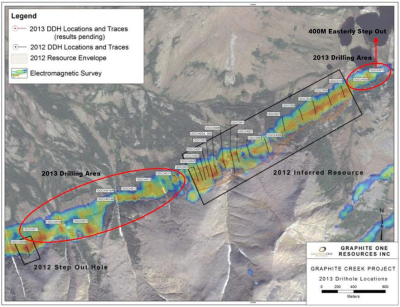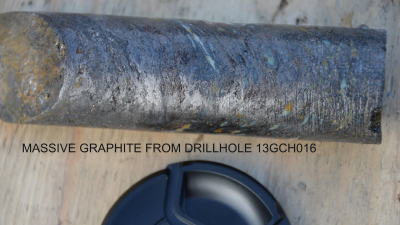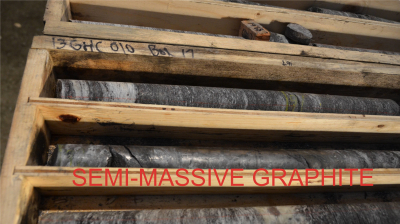November 13, 2013 - Calgary, Alberta - Graphite One Resources Inc. (GPH: TSX-V, GPHOF: OTCQX) ("Graphite One" or the "Company") is pleased to announce the results of the first two holes of a recently completed ten-hole diamond drill program (see press release dated September 24, 2013).
Highlights:
-Holes 13GCH009 and 010 intercept significant widths of high grade, near surface graphite extending mineralization an additional 400m to the east
-2013 drilling expands drilled strike length 120% to 4.9km
-Further confirms excellent continuity with simple geological structures
-Updated 43-101 to be completed after all 2013 drilling results have been received
Graphite One has received results for drill-holes 13GCH009 and 13GCH010 which tested surface graphite showings with a coincident high priority Electro-Magnetic conductor, approximately 400m east of the existing Inferred Resource delineated during 2012 (see map attached). The results are summarized in the Table below and highlights include 102.11m of 3.27% Graphitic Carbon ("Cg"); including 39.85m of 7.13% Cg and 16.2m of 10.22% Cg. All drill holes will be used to produce an updated NI 43-101 compliant graphite resource. Drill sections are attached in an Appendix.
Graphite One has its own core logging and sample preparation laboratory / facility in Nome, Alaska. The sample preparation laboratory was installed, and is being managed by Actlabs, Ancaster, Ontario. This will ensure Graphite One maintains the highest level of QA/QC and ensures timely receipt of analytical results. All analyses were completed at Actlabs.
"These exceptional results continue to demonstrate the continuity of this near surface resource providing further evidence that this will be one of the most significant, coarse flake graphite resources in the world. Being an advanced stage graphite deposit in the United States is a significant advantage, for both permitting, funding and off take strategies in the future." stated Anthony Huston, President and Director for Graphite One Resources.
------------------------------------------------------------------- |DRILL HOLE |Azimuth|Dip|Depth |Intersection (m)|Graphite| | | | | | |(% Cg)* | | | | |---------------| | | | | | |From (m)|To (m)| | | |-----------------------------------------------------------------| |13GCH009 |160 |-50|15.00 |115.25|90.25 |3.64% | |-----------------------------------------------------------------| |……including| | |41.84 |75.00 |33.16 |7.02% | |-----------------------------------------------------------------| |……including| | |61.00 |73.84 |12.84 |9.71% | |-----------------------------------------------------------------| |13GCH010 |160 |-50|11.89 |114.00|102.11 |3.27% | |-----------------------------------------------------------------| |……including| | |55.15 |95.00 |39.85 |7.13% | |-----------------------------------------------------------------| |……including| | |58.00 |74.20 |16.20 |10.22% | -------------------------------------------------------------------
The Graphite Market
China currently produces approximately 70% of the world's graphite (world production is approximately 1,100,000 tonnes of which 400,000 is flake graphite) and has recently restricted exports by instituting an export tax. As well, the Chinese government has banned any new graphite plants and imposed strict environmental regulations on existing plants in Qingdao. A state owned amorphous graphite monopoly has been formed which will consolidate 210 amorphous graphite mines down to 20 and will reduce production capacity from 600,000 to 510,000 tonnes per year. The implementation of these new rules and standards will make graphite mines much more difficult to build and/or operate in China. Recently, South Graphite, which was formed in 2011 to consolidate all the amorphous graphite resources in Hunan, China (which is the world's largest graphite producer) and has a total production capacity of approximately 200,000 tonnes per annum.
Graphite is an allotrope of carbon along with diamonds and coal. Graphite is the best known conductor of heat and electricity. Graphite and graphite powder are valued in industrial applications for their self-lubricating and dry lubricating properties. It maintains its strength and stability to temperatures in excess of 3,000?C and is resistant to chemical attack. Graphite demand was historically driven by the steel and automotive industries. Due to the industrialization of BRIC (Brazil, Russia, India, China) economies, Graphite demand has steadily increased by 5% per annum since 2000. Global graphite demand is growing rapidly and is expected to continue based on new applications and green technologies, including but not limited to: hybrid-electric vehicles (HEVs); plug-in hybrid-electric vehicles (PHEVs); battery-electric vehicles (BEVs); fuel cells; Lithium-Ion Batteries; Pebble Bed Nuclear Reactors; lubricants and Graphene.
As global demand grows, graphite prices have increased substantially, more than doubling over the past three years. Both the European Union and the United States have declared graphite a supply critical mineral.
About Graphite Creek
The Graphite Creek Property comprises 129 claims totaling 6,799 hectares on the Seward Peninsula of Alaska, 65 kilometres north of a deep sea port at Nome. The Property is only 18km from a seasonal road and approximately 30 kilometers from a newly proposed deep sea port west of Teller (Port Clarence), which could be accessible by either land or water. Typically, graphite ore is processed into a size-sorted rough concentrate on site using a crushing, grinding, floatation and sieving circuit. Product is transported to end users as palletized material in either 20kg bags or in bulk.
Mineralization at the Graphite Creek Property is characterized by coarse crystalline (large flake) graphite (greater than 80 mesh) within graphite-bearing schist(s). Graphite mineralization is exposed at surface. The large flake graphite occurs as disseminations and high grade segregations and lenses in distinctive sillimanite-garnet-quartz-biotite schist(s) and/or quartz-biotite schist(s). The host schist(s) is continuous over 18 kilometres of strike length, based on mapping, sampling and airborne geophysics. Please refer to the January 21, 2013 press release where Graphite One reports the filing of a NI43-101 Technical Report with an inferred resource of 164.5 million tonnes at 4.61% graphite (including 25.44 million tonnes at 9.69% graphite and 7.8 million tonnes at 13.49% graphite).
During 2011, Graphite One tested 3 samples from surface at the Graphite Creek area (where the 2012 drilling was focused) for flake size analysis. The samples analyzed included: (1) high grade rock grab samples (assayed 56.9%C); (2) mixed grade rock grab samples (disseminated and high grade material mixed (assayed 14.5%C)); and (3) rock grab samples with disseminated graphite (assayed 8.2% C). From these samples, 84.3%; 93.6% and 76.5% of graphite recovered are large flakes respectively (greater than 80 mesh). Specifically, the majority of the recovered graphite in the samples is considered to be large flake. Furthermore, the majority of the large flake graphite is greater than 40 mesh (64.8%, 65.8% and 73.3%, respectively) and is considered Jumbo Flake. The analytical work was conducted at Hazen Laboratories, Co, USA.
During 2012, Graphite One tested 4 samples from drill core for flake size analysis. The samples analyzed contained 8.7%, 13.7%, 14.9% and 8.0% Cg, respectively. From these samples 62.9%, 70%, 63.9%, and 59.3%* of the graphite recovered are large flakes (*samples were crushed to 10 mesh so results may be understated because the 2011 samples contained up to 10.5% +10 mesh material). The analytical work was conducted at Hazen Laboratories, Co, USA. Based on the 2011 and 2012 tests, the Graphite Creek Property is known to be a flake graphite deposit whereby the majority of the flake is considered to be large flake.
About Graphite One Resources Inc.
GRAPHITE ONE RESOURCES INC. (GPH: TSX-V; GPHOF: OTCQX) is a mineral exploration company with extensive experience in the state of Alaska and a business strategy to identify, acquire, and explore high potential projects ready for rapid advancement. The Graphite Creek Property on the Seward Peninsula of Alaska fits with the Graphite One business strategy offering significant potential for the discovery and development of a large flake, graphite deposit exposed at surface. Graphite One has an option to earn a 100% interest in the Graphite Creek Property.
Dean Besserer, P.Geol., Vice President of Exploration for the Company and a "Qualified Person" under NI 43-101, is responsible for and has reviewed and approved the technical content of this press release.
ON BEHALF OF THE BOARD OF DIRECTORS
"Charles Chebry" (signed)
For more information on Graphite One Resources Inc. please visit the Company's website, www.GraphiteOneResources.com or contact:
Anthony Huston
President & Director
Tel: (604) 697-2862
Email: [email protected]
Neither the TSX Venture Exchange nor its Regulation Services Provider (as that term is defined in the policies of the TSX Venture Exchange) accepts responsibility for the adequacy or accuracy of this release.
This release includes certain statements that may be deemed to be forward-looking statements. All statements in this release, other than statements of historical facts that address access to capital, regulatory approvals, exploration drilling, exploitation activities and events or developments that the Company expects, are forward-looking statements. Although the Company believes the expectations expressed in such forward-looking statements are based on reasonable assumptions, such statements are not guarantees of future performance and actual results or developments may differ materially from those in the forward-looking statements. Factors that could cause actual results to differ materially from those in forward-looking statements include market prices, exploitation and exploration successes, continuity of mineralization, uncertainties related to the ability to obtain necessary permits, licenses and title and delays due to third party opposition, changes in government policies regarding mining and natural resource exploration and exploitation, and continued availability of capital and financing, and general economic, market or business conditions. Readers are cautioned not to place undue reliance on this forward-looking information, which is given as of the date it is expressed in this press release, and the Company undertakes no obligation to update publicly or revise any forward-looking information, except as required by applicable securities laws. For more information on the Company, investors should review the Company's continuous disclosure filings that are available at www.sedar.com.
The mineral resource estimates reported in this press release were prepared in accordance with Canadian National Instrument 43-101 Standards of Disclosure for Mineral Projects ("NI 43-101"), as required by Canadian securities regulatory authorities. For United States reporting purposes, the United States Securities and Exchange Commission ("SEC") applies different standards in the classification of mineralization. In particular, while the terms "measured," "indicated" and "inferred" mineral resources are required pursuant to NI 43-101, the SEC does not recognize such terms. Canadian standards differ significantly from the requirements of the SEC. Investors are cautioned not to assume that any part or all of the mineral deposits in these categories constitute or will ever be converted into reserves. In addition, "inferred" mineral resources have a great amount of uncertainty as to their existence and great uncertainty as to their economic and legal feasibility. It cannot be assumed that all or any part of an inferred mineral resource will ever be upgraded to a higher category. Under Canadian securities laws, issuers must not make any disclosure of results of an economic analysis that includes inferred mineral resources, except in rare cases.
APPENDIX






